Normally in these articles about magazine writing, I focus on positive ways to make a difference. From my years in the publishing world, I understand that sometimes a list of negatives can also make an impact. I’m taking a different slant (a magazine writing term).
While you probably don’t know it, if you violate one or several of these methods, your article or query will not be considered but quickly rejected. The reverse is also true: if you avoid all these ways you will give your submission a greater chance of acceptance and publication.
- Not Following the Submission Guidelines
Editors have made the effort to tell you what they want for their publication. This document is called the submission guidelines. They will mail it to you if requested or you can find it on the publication website. Use GOOGLE to located these guidelines, read and then follow the editor’s directions. These guidelines will highlight the different types of articles that are wanted and the specifics like word count or whether they want the full article or a query letter. They will also tell you whether they pay on assignment or on publication and how much they will pay. As you know these details and follow them, it will increase your possibilities of success with print magazines.
- Not Properly Formatting Your Article
Most word processors will come with a default font like Arial but magazine editors prefer a serif font like New Times Roman or Georgia. Also they prefer the top of the first page to include your name, mailing address, phone and word count and the rights you are offering (first rights or reprint rights). Also proper formatting includes sending a short bio at the end of the article.
If your submission is properly formatted then you gain a reading or hearing from the editor. If it is not formatted, you risk instant rejection.
- Wrong Word Count—Too Long or Too Short
Magazine writing is about strong communication in a limited amount of space. It’s not 140 characters like a tweet but it is restricted. It is all about meeting the expectations of the editor. If the editor wants 500 words on a topic, then send him 500 words. If you send 800 words and assume the editor will cut the 300 words he doesn’t need because editors edit. Then you are risking rejection or at best, a rewrite request from the editor.
- No Takeaway for the Reader
Every magazine article is ultimately about a single point for the reader. This single point is called a takeaway. If you have written a personal experience article, what is the point of that article that you want the reader to carry away from the article? From reviewing many magazine submissions, often articles are rejected because they did not include this single point or takeaway for the reader. When I worked at Decision magazine, 1.8 million copies an issue, sometimes as editors we added a sentence takeaway at the end of the article. Sometimes it was a statement and other times is was a provocative question. No matter what type of magazine article you are writing, every one has a takeaway. If your article does not, then you risk rejection.
- Missing a Key Element in the Story
Magazine articles must have a great opening story or question or quotation. They must also have a straightforward overall structure—a beginning, a middle and an ending. If your article wanders all around without a point or solid storytelling or structure, then again you risk rejection and not acceptance.
The magazine world is all about making a good and lasting impression and forming a relationship. You want to be the writer that the editor reaches out to and asks you to write a specific article (assignment). Every magazine has a “stable” of writers who contribute to the publication on a regular basis. Then when the editor has an idea for his publication, he turns to those writers who have been contributing regularly.
The journey of becoming one of those stable writers begins with a single step—consistent and professional action. Stay away from these turn offs.
________________________________________
Terry Whalin, a writer and acquisitions editor at Morgan James Publishing, lives in Colorado. A former magazine editor, Whalin has written for more than 50 publications including Christianity Today and Writer’s Digest. He has written more than 60 nonfiction books including Jumpstart Your Publishing Dreams. His latest book is Billy Graham, A Biography of America’s Greatest Evangelist and the book website is at: http://BillyGrahamBio.com Watch the short book trailer for Billy Graham at: http://bit.ly/BillyGrahamBT His website is located at: www.terrywhalin.com. Follow him on Twitter at: https://twitter.com/terrywhalin






 We love helping your growing in your writing career.
We love helping your growing in your writing career.

Terry, Great article. These don’ts are for agents and publishers too. Thank you for the insight.